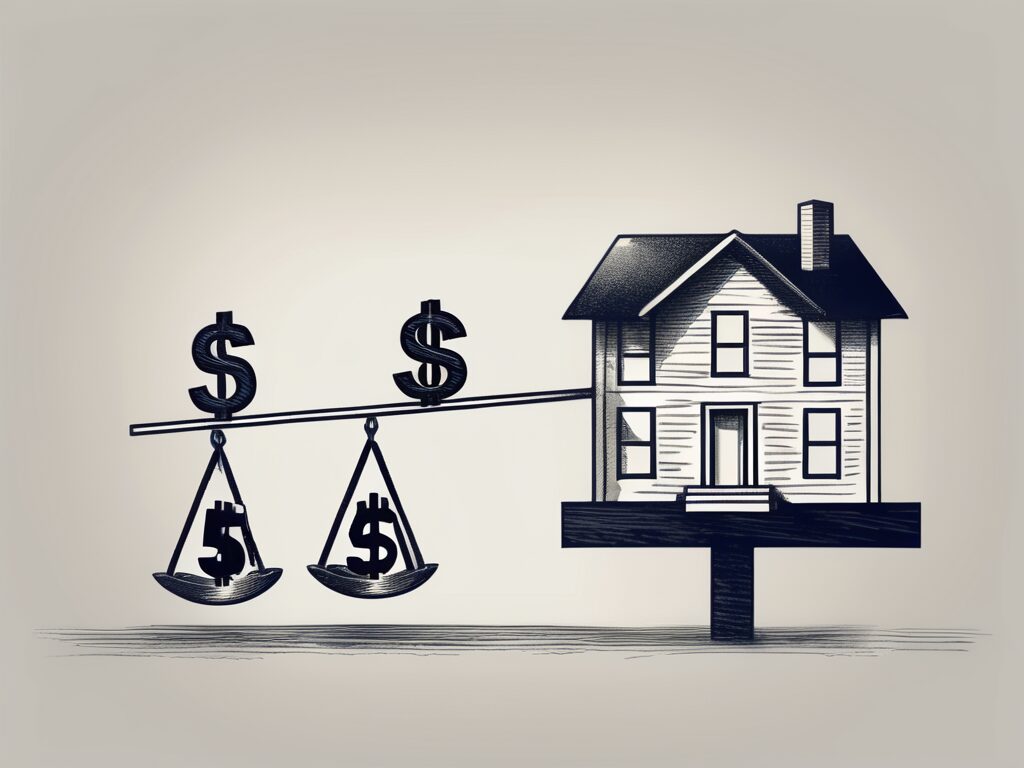
Agent A-Team or Solo Superhero? Finding the Right Real Estate Partner for Your Selling Journey in Wildwood Florida
When it comes to selling your home in Wildwood, Florida,…
January 29, 2024
In the world of mortgage loans, there are various options available to borrowers. One popular choice is the 5/1 ARM loan, which offers flexible terms and potential cost savings. If you’re considering a 5/1 ARM loan for your next home purchase or refinance, it’s important to understand how it works and whether it’s the right choice for you. In this comprehensive guide, we’ll explore the ins and outs of 5/1 ARM loans, weigh the pros and cons, compare them to fixed-rate mortgages, and answer common questions that borrowers may have.
A 5/1 ARM loan, also known as a hybrid adjustable-rate mortgage, is a type of mortgage that has a fixed interest rate for the first five years and then adjusts annually based on a predetermined index and margin. This means that your monthly mortgage payment will remain the same for the initial five-year period, and after that, it may increase or decrease depending on market conditions.
Before delving further into the mechanics of a 5/1 ARM loan, let’s explore how and when the interest rate on these loans adjusts.
The interest rate on a 5/1 ARM loan adjusts annually after the initial fixed-rate period. The adjustment is based on a specific index, such as the U.S. Treasury bill rate or the London Interbank Offered Rate (LIBOR), plus a margin determined by the lender. The margin remains constant throughout the life of the loan, while the index fluctuates with market conditions.
For example, if the initial fixed rate on your 5/1 ARM loan is 3%, and the margin is 2.5%, your interest rate for the first five years will be 5.5%. After the initial five-year period, if the index rate is 3%, your new interest rate will be 5.5% + 3% = 8.5%. If the index rate increases to 4% in the following year, your interest rate will adjust to 5.5% + 4% = 9.5%.
The adjustment period and rate cap limits are outlined in the loan agreement and can vary depending on the lender and loan program.
The first adjustment typically occurs after the initial fixed rate period ends, which is five years in the case of a 5/1 ARM loan. Subsequent adjustments occur annually based on the index value at that time. Borrowers should be aware of the adjustment frequency and factor it into their financial planning.
It’s worth noting that interest rate adjustments can lead to changes in your monthly mortgage payment, so it’s important to budget accordingly and be prepared for potential increases or decreases in your payment amount.
The index is a benchmark interest rate used to determine the adjustment of the loan’s interest rate. Commonly used indexes include the U.S. Treasury bill rate, the LIBOR, or the Constant Maturity Treasury (CMT) rate. The specific index used for your 5/1 ARM loan will be stated in your loan agreement.
It’s important to understand how your loan’s index behaves and how it can impact your interest rate. Some indexes may be more volatile than others, meaning your interest rate could fluctuate more frequently or dramatically depending on which index is used. Research the historical performance of the index to gain insights into its potential future movements.
Let’s consider a hypothetical scenario to illustrate the impact of interest rate adjustments on a 5/1 ARM loan payment. Suppose you secure a 5/1 ARM loan for $300,000 with an initial fixed rate of 3% and a margin of 2.5%. In the first five years, your monthly mortgage payment, including principal and interest, would be $1,265.79.
After the initial fixed-rate period, if the index rate increases, let’s say to 4%, your new interest rate would be 5.5%. At that point, your monthly payment would increase to $1,678.82. If the index rate then decreases to 3%, your interest rate would be 5.5%, and your monthly payment would revert to $1,577.22. This example demonstrates how interest rate fluctuations can impact your monthly payment.
Now, let’s delve deeper into the advantages and disadvantages of a 5/1 ARM loan.
One of the main advantages of a 5/1 ARM loan is the lower initial interest rate compared to a traditional fixed-rate mortgage. This can result in lower monthly mortgage payments during the first five years of the loan term. Additionally, if you plan to sell your home before the end of the initial fixed-rate period, you can take advantage of the lower interest rate without worrying about potential rate adjustments.
Another advantage is that 5/1 ARM loans often have rate caps, which limit how much your interest rate can increase or decrease during each adjustment period and over the life of the loan. This provides some protection against significant rate hikes and helps borrowers budget for potential changes in their monthly payments.
While a 5/1 ARM loan offers some benefits, it also comes with potential drawbacks. One disadvantage is the uncertainty of future interest rate adjustments. Since the interest rate can change annually after the initial fixed-rate period, borrowers may face higher monthly payments if rates rise significantly.
Additionally, if you plan to stay in your home beyond the initial fixed-rate period, you run the risk of facing higher interest rates and potentially larger monthly payments. This uncertainty can make financial planning more challenging, especially if you have a tight budget.
Furthermore, if you decide to refinance your 5/1 ARM loan after the initial fixed-rate period, you may encounter higher interest rates compared to when you first obtained the loan. This can impact your overall cost of borrowing and should be considered when evaluating the long-term affordability of the loan.
It’s important to carefully weigh the advantages and disadvantages of a 5/1 ARM loan and consider your financial goals, future plans, and risk tolerance before deciding if this type of mortgage is right for you.
Now that we’ve covered the basics of a 5/1 ARM loan, let’s examine the advantages and disadvantages to help you decide whether it’s the right choice for you.
Before committing to a 5/1 ARM loan, it’s essential to evaluate your financial situation and future plans. Consider factors such as your income stability, employment prospects, and long-term homeownership goals. If you anticipate an increase in income or plan to sell your home before the adjustment period begins, a 5/1 ARM loan could be a suitable option.
However, it’s important to note that while a 5/1 ARM loan may offer initial lower interest rates, there is a level of uncertainty associated with adjustable-rate mortgages. The interest rate and monthly payment can change after the initial fixed-rate period, which is something to keep in mind when making your decision.
It’s also important to factor in potential rate adjustments to ensure you can afford any increases in your monthly payment. Carefully assess your budget and determine whether you have the financial flexibility to handle potential adjustments.
Current market conditions can influence the attractiveness of adjustable-rate mortgage loans. If interest rates are low and are expected to remain relatively stable for the foreseeable future, a 5/1 ARM loan could be an appealing option. However, it’s essential to remember that interest rates can fluctuate, and future increases could impact your mortgage payment.
Consult with industry professionals, such as mortgage brokers or financial advisors, to gain insights into current market conditions and make an informed decision.
Additionally, it’s worth considering the potential advantages of a 5/1 ARM loan. For example, if you plan to stay in your home for a relatively short period, such as five years, a 5/1 ARM loan could provide you with the opportunity to take advantage of lower interest rates during the fixed-rate period.
Furthermore, a 5/1 ARM loan can be beneficial if you expect your income to increase significantly in the near future. As your income rises, you may be better equipped to handle potential rate adjustments and higher monthly payments.
On the other hand, if you anticipate a decrease in income or have concerns about your ability to handle potential rate increases, a 5/1 ARM loan may not be the best choice for you. It’s crucial to carefully consider your financial circumstances and future plans before making a decision.
Remember, every individual’s financial situation is unique, and what works for one person may not work for another. Take the time to thoroughly evaluate your options and consult with professionals who can provide personalized advice based on your specific needs and goals.
When it comes to choosing a mortgage, borrowers often find themselves torn between the flexibility of a 5/1 ARM loan and the stability of a fixed-rate mortgage. Both options have their advantages and disadvantages, and understanding the key differences between them is crucial in making an informed decision.
A fixed-rate mortgage provides borrowers with stability and predictability. With this type of loan, the interest rate remains unchanged throughout the entire term, resulting in consistent monthly payments. This can be particularly beneficial for individuals who prefer a budget-friendly approach and want to avoid any surprises in their mortgage payments.
On the other hand, a 5/1 ARM loan offers borrowers more flexibility. The “5/1” refers to the initial fixed-rate period of five years, during which the interest rate and monthly payments remain constant. After the initial period, the rate adjusts annually based on market conditions. This can be advantageous for those who anticipate changes in their financial situation or plan to sell their home within a few years.
For borrowers seeking a longer initial fixed-rate period, a 7/1 ARM loan might be a better fit. Similar to a 5/1 ARM loan, the interest rate and monthly payments remain unchanged for the first seven years of the loan term. However, after the initial period, the rate adjusts annually. This option is ideal for individuals who plan to stay in their home for a longer period and want to enjoy the stability of a fixed rate for a longer duration.
When deciding between a 5/1 ARM and a 7/1 ARM loan, it’s essential to consider your plans and financial goals. Evaluate factors such as future income expectations, stability in your job or career, and housing market conditions in your area. These considerations will help you determine which option aligns best with your needs.
For borrowers who desire an even longer initial fixed-rate period, a 10/1 ARM loan may be worth considering. With this type of loan, the interest rate remains fixed for the first ten years, providing borrowers with extended stability. This option is particularly suitable for individuals who plan to stay in their homes for an extended period and want to ensure consistent monthly payments.
When comparing a 7/1 ARM to a 10/1 ARM, it’s crucial to evaluate your long-term homeownership goals and financial plans. Will you be moving or refinancing within the next ten years? If not, a 10/1 ARM could be a more suitable option, as it offers a longer fixed-rate period and greater stability.
Qualifying for a 5/1 ARM loan follows a similar process as qualifying for other types of mortgage loans. Lenders typically consider factors such as credit score, income, employment history, debt-to-income ratio, and down payment amount when evaluating your loan application.
Before applying for a 5/1 ARM loan, it’s essential to review your credit report, address any outstanding debts, and ensure your financial documents are organized and up-to-date. Taking these steps will help streamline the mortgage approval process and increase your chances of securing the loan.
Interest rates fluctuate, and the rate you’re offered will depend on various factors, including market conditions, your creditworthiness, and the lender you choose. To increase your chances of securing the lowest 5/1 ARM rates, consider the following tips:
5/1 ARM loans are available through various loan programs, including conventional, FHA, and VA loans. Each program has its own eligibility requirements and underwriting standards. It’s important to evaluate each loan program to determine if a 5/1 ARM option is available and suitable for your needs.
When exploring loan programs, consider factors such as the required down payment, mortgage insurance requirements, and closing costs. Consulting with lenders or mortgage brokers who specialize in different loan programs can help you explore your options and find the best fit for your circumstances.
Lastly, let’s address some of the common questions that borrowers may have about 5/1 ARM loans.
The interest rate on a 5/1 ARM loan adjusts annually after the initial fixed-rate period, which lasts five years.
Yes, it’s possible to refinance a 5/1 ARM loan. Refinancing allows you to replace your existing loan with a new loan that has different terms, potentially providing benefits like a lower interest rate or monthly payment.
Yes, many lenders allow borrowers to make additional payments towards their principal balance. Making extra payments can help reduce the overall interest paid on the loan and potentially shorten the loan term.
Some lenders offer options to convert an adjustable-rate mortgage into a fixed-rate mortgage. However, specific terms and requirements vary by lender and loan program. Consult with your lender to explore the possibility of converting your 5/1 ARM loan.
If you’re unable to make the higher mortgage payment after the interest rate adjustment, it’s crucial to contact your lender immediately. In some cases, your lender may be able to offer assistance or modify the loan terms to accommodate your financial situation.
No, a 5/1 ARM loan may be suitable for some borrowers, but not for everyone. It’s essential to carefully evaluate your financial goals, current financial situation, and risk tolerance before choosing a mortgage loan. Consider consulting with a financial advisor or mortgage professional to determine the best loan option for your individual circumstances.
5/1 ARM loans can be more affordable than fixed-rate mortgages in the short term due to their lower initial interest rates. However, it’s important to remember that the interest rate can adjust after the fixed-rate period, potentially leading to higher monthly payments in the future. Consider your long-term financial plans when weighing affordability.
By understanding the ins and outs of 5/1 ARM loans, you can make an informed decision that aligns with your financial goals and homeownership plans. Evaluate the pros and cons, compare loan options, and consider seeking expert advice when necessary. With careful consideration and diligent research, you’ll be equipped to navigate the world of mortgage loans and secure the best option for your needs.
As you consider the financial implications of a 5/1 ARM loan for your home purchase or refinance, remember that understanding your property’s value is just as crucial. Richr is here to help. Take advantage of our free home valuation service to make informed decisions about your mortgage options. Ready to get started? Call Richr on 844-957-4247 today for a complimentary Comparative Market Analysis (CMA) and take the first step towards smart homeownership.

If you want the Richr team to help you save thousands on your home just book a call.
 Book a call
Book a call